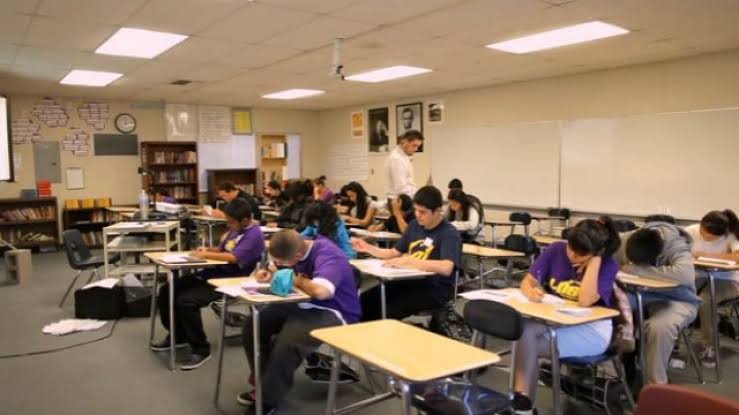Know Why is the Education in the US So Popular Among Students Globally
The education system in the USA is unique. Read about the US grading system, school hours, and many more things here.

The education system of the USA is always in talks because it is unlike that in many other countries. Maybe because the United States central government does not control the educational system, but their education is primarily the responsibility of state and local government.
Besides that, the American education system provides a wide range of fields of choices for international students. Moreover, a broad array of schools, locations, and programs may overwhelm students, even those from the US.
So if you have the curiosity to know more about Education in the United States of America, you are in the right place. Here we will learn more about the system that will not only educate you about the place but will also help you to narrow your choices and develop your education plan if you are thinking about it.
About Grading Systems in the USA

If you do not belong from America, you will have to submit your academic transcripts as part of your application for admission to university or college, just like American students. The official copies of your academic work are known as Academic transcripts. And, this includes your “grades” and “grade point average (GPA), which are measurements of your academic achievement. Commonly, the courses are graded using percentages, which are converted into letter grades.
Well, for international students, the grading system and GPA in the US can be confusing because the interpretation of grades has a lot of variation there. For a case, two students attend different schools and submit their transcripts to the same university. They both have 3.5 GPAs, but still one of them attended a prestigious school that was academically challenging, and the other one attended an average high school.
So, since the two schools have dramatically different standards, the university might interpret their GPAs differently.
Hence, here are a few crucial things to keep in mind:
1. You must find out the U.S. equivalent of the last level of education you have completed in your homeland.
2. Give huge attention to the admission requirements of each college and university, as well as individual degree programs, that may have different terms & conditions or requirements than the university.
3. To make sure you are meeting the requirements, meet with an educational advisor or guidance counselor.
So, whether or not you should spend an extra year or two preparing for U.S. university admission, your educational advisor or guidance counselor will be able to advise you on. Because if being an international student, you enter a U.S. college or university even before being eligible to attend university in your own country, then some countries’ governments and employers may not recognize your U.S. education.
Academic Duration in the United States of America

Usually, the school calendar begins in August or September and continues through May or June. It could be said that the majority of the new students begin their Academic year in Autumn. So, if you are an international student, you can also begin your U.S. university studies at this time.
No doubt, at the beginning of the school year, there is a lot of excitement in the students as they form many great friendships during this time. And, this is because they are all adjusting to a new phase of academic life. Plus, starting in autumn and continuing through the year, many courses are designed for students to take them in sequence.
At many schools, the academic year is composed of two terms called “semesters.” Well, some of the schools also use a three-term calendar known as the “trimester” system. However, including an optional summer session, some also further divide the year into the quarter system of four terms. Fundamentally, the academic year is either comprised of two semesters or three-quarter terms if we exclude the summer session.
Primary and Secondary Education in the USA

Students of America attend primary as well as a secondary school that is for a combined total of 12 years before higher education. And, such years are referred to as the first through twelfth grades here.
Moreover, U.S. children begin primary school around the age of six, which is usually called “elementary school.” They study five or six years and later move on towards secondary school.
Further, the Secondary schools consist of two programs: the first program is “junior high school” or “middle school,” and the second one is “high school.” Then upon graduation from high school, a diploma or certificate is awarded. And, after graduating high school (12th grade), U.S. students may go on to college or university. The College or university study is known as “higher education.”
The Higher Education System in the USA

There are several levels of Higher education in the USA. Like:
1. First Level: Undergraduate
2. Second Level: Graduate in Pursuit of a Master’s Degree
3. Third Level: Graduate in Pursuit of a Doctorate or Doctoral Degree
Let’s learn briefly about all the levels of Higher Education in the United States of America to understand well.
1. Undergraduate
A student who has not earned a bachelor’s degree and is attending a college or university is studying at the undergraduate level. To earn a bachelor’s degree, it typically takes about four years. There are two ways you can begin your studies: either a four-year university or college or in pursuit of a bachelor’s degree at a community college.
One will generally be required to take a wide variety of classes in different subjects in the first two years of their study, commonly known as prerequisite courses: literature, the social sciences, science, history, the arts, and so forth. And, in this way, one will achieve some general knowledge, a foundation, of a different type of subject earlier to focusing on a specific field of study.
To complete the first two years of prerequisite courses, many students choose to study at a community college. This way, they will earn an Associate of Arts (AA) transfer degree and then transfer to a four-year university or college.
The specific field of study in which your degree is focused on is “major.” For example, someone will earn a Bachelor of Arts in Journalism if their major is in journalism. To meet the degree requirements of your major, you will be required to take a certain number of courses in this field. At the beginning of your third year of school, you need to choose your major.
Here comes one very unique characteristic of the American higher education system, i.e., one can change their major multiple times if they want. That means, for American students, it is extremely common to switch majors at some point in their undergraduate studies.
Besides, it is also common that students keep discovering that in what field they excel in or will enjoy so they can switch if needed. Hence, it proves how the American education system is extremely flexible. However, keep in mind that switching majors means more time and money and more courses.
2. Second Level: Graduate in Pursuit of a Master’s Degree
Currently, to enter certain professions or advance their careers, a college or university graduate with a bachelor’s degree may want to think seriously about graduate study. Well, for higher-level positions in library science, behavioral health, engineering, and education, this degree is usually mandatory.
However, make sure that international students from some specific countries are only allowed to study abroad at a graduate level. So, before you apply to a postgraduate university in the USA, you must inquire about the credentials needed to get a job in your country.
Furthermore, a graduate program is simply a division of a college or university. So, one will need to take the GRE (graduate record examination) to gain admission. Some specific tests are required for certain master’s programs, for example, for business school: the GMAT or GRE, for law school: the LSAT, and for medical school: the MCAT.
In pursuit of a master’s degree, graduate programs typically take one to two years to complete. For example, an extremely popular degree program, the MBA (master of business administration), takes about two years. And, some other master’s programs, for example, journalism, only take one year.
A graduate student must prepare a long research paper called a “master’s thesis” or complete a “master’s project.” Besides that, the majority of a master’s program is spent in “classroom study.”
3. Third Level: Graduate in Pursuit of a Doctorate or Doctoral Degree
According to many graduate schools, the attainment of a master’s degree is simply the first step towards earning a Ph.D. (doctorate). But at some other schools, without even earning a master’s degree, students may prepare directly for a doctorate. If we talk about the time duration, it may take three years or more to earn a Ph.D. degree. But, it may take as long as five or six years for international students.
Most doctoral degree candidates enroll in seminars and classes for the first two years of the program. And, one of the two years is spent conducting firsthand research and writing a dissertation or thesis. Plus, as per the rule, this paper must comprise views, research, or designs that have not been earlier published.
A discussion and a summary of the current scholarship on a given topic is a doctoral dissertation. In most U.S. universities, there is a rule that awarding doctorates’ candidates must have at least a reading knowledge of two foreign languages, succeed in a qualifying examination that officially enrolled candidates to the Ph.D. program, spend a required length of time “in residence,” and pass an oral examination on the same topic as the dissertation.
Role of the U.S. Government in Education

As we already mentioned above, the United States central government does not control the educational system, unlike in many other countries. Because instead of that, the higher education systems are either:
1) Controlled by independent groups of trustees, or people (especially in the case of private schools); or
2) Shared between state and local governments (especially in the case of public schools).
The major difference between these two types of schools is the cost. As per the scenario, Private schools are generally much more pricey to attend in comparison to public school counterparts. And, the reason may be because private schools must rely on sources outside of the government for their funding.
Plus, the Department of Education of the U.S. recognizes and reviews “accrediting agencies” that further ensures the quality of the school and its programs. However, many universities and colleges have “regional accreditation” from an agency that oversees that particular part of the country where the school is located.
All you need is to ensure that the school you choose has accreditation, meaning that it has met specific academic, financial, and administrative standards. Accreditation also assures that a degree of yours will be recognized by other educational institutions as well as employers.
Moreover, in addition to regional accreditation, certain fields of study will also have “program accreditation.” For example, technology accredits engineering programs with the Accrediting Board of Engineering. If program accreditation exists in your field of study, your overseas educational adviser can help you find out.
Characteristics of the U.S. Higher Education System

1. Classroom Environment
The classroom atmosphere of American universities is very dynamic. Once you enroll here, you will be expected to share your opinion, participate in class discussions, argue your point, and give presentations. According to the surveys, International students find this as one of the most surprising aspects of the American education system.
Moreover, professors keep on assigning textbooks and other readings almost every week. And from your end, you need to keep up-to-date with the required readings and homework so you can participate in class discussions and understand the lectures. And on such a basis only, Professors give grades to students.
Usually, grades are based upon:
a. Generally, students are expected to participate in class discussions, especially in seminar classes, but each professor will have a unique set of class participation requirements. While determining a student’s grade, this is often a very important factor for them.
b. Typically, a midterm examination here is given during class time.
c. As we mentioned above, one or more term or research papers or laboratory reports must be submitted for evaluation.
d. Possible short quizzes or exams are given. It is a trend here that many times, professors give an unannounced “pop quiz.” Well, this is to inspire students to keep up with their assignments and attendance; hence, it doesn’t count profoundly toward the grade.
e. Then, after the final class meeting, a final examination will be held.
2. Credits
Another best thing about studying here is each course is worth a certain number of credits or credit hours. Any course is usually worth three to five credits.
At most schools, a full-time program is 12 or 15 credit hours (four or five courses per term), and to graduate, a certain number of credits must be fulfilled. During each term, International students are expected to enroll in a full-time program.
3. Transfers
Generally, most credits earned at the first school can be used to complete a degree at the new university, even if a student enrolls at a new university before finishing a degree. This means a student can easily graduate within a reasonable time, even if they transfer to another university in mid.
Concluding Thoughts
So, we have seen the whole structure of Education in the United States of America. And, now as we know such unique features about their And now as we know such unique features about their Education system hence we can understand why it is so popular all over the world.
If you are also planning to move there for your education, I think this much information will be enough to know at a basic level.
I hope you enjoyed reading the article!
Popular Posts
20 Most Powerful Goddess Names In Mythological World
From Gaia to Kali; every goddess in mythologies have a prominent role to create or restore the balance in nature and the universe.
Kimberly Campbell
21 Gods & Goddesses of Destruction, Death & Underworld
This list showcases the Gods of death, the Underworld, and destruction: from the Egyptian God of Death- Anubis, who was recognized as a man with a jackal head, to the Hindu God of Death- “Yama,” who took the records of each person’s death. But Thanatos was the personified spirit of non-violent death.
Rupesh Chhabra
14 of the Renowned Gods and Goddess of Healing & Medicine
No wonder, the God of healing and magical tradition allied to it, never failed to surprise people especially in ancient times. Let’s discover some of God and Goddess of healing and their amazing contribution.
Rupesh Chhabra








